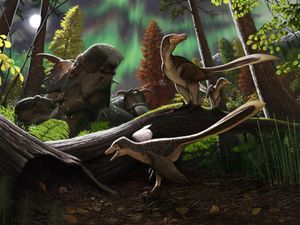Scientists may have found new dinosaur species that roamed the ancient Arctic
The findings are based on a ‘rare’ piece of dinosaur jawbone thought to a juvenile dromaeosaurid dinosaur.

Scientists believe they may have stumbled on new species of dinosaur that lived in the Arctic 70 million years ago, when the region was warmer than it is now.
The findings are based on a “rare” piece of dinosaur jawbone thought to belong to a juvenile dromaeosaurid dinosaur, predatory animals closely related to birds.
Dromaeosaurids, whose members include the velociraptor, lived during the Cretaceous period, between 145-66 million years ago.
Teeth remains of these creatures have previously been found in North America, South America, and Asia but lack of bone fossil records have made it hard for palaeontologists to trace the paths the domaeosaurids took as they dispersed between continents.
Many scientists believe the Arctic was a “migratory pathway” for many dinosaurs when they crossed between Asia and North America.
But researchers now say the discovery of the jawbone fossil of a juvenile appears to contradict these suggestions and believe the animals lived there all year round.
The palaentologists say that the early developmental stage of the bone suggests the young dromaeosaurid was born nearby, strong evidence that some of dinosaurs were nesting there.

Anthony R Fiorillo, of Southern Methodist University, and one of the authors of the study published in the journal Plos One, said: “Years ago when dinosaurs were first found in the far north, the idea challenged what we think we know about dinosaurs.
“For some time afterwards, there was a great debate as to whether or not those Arctic dinosaurs migrated or lived in the north year round.
“All of those arguments were somewhat speculative in nature.
“This study of a predatory dinosaur jaw from a baby provides the first physical proof that at least some dinosaurs not only lived in the far north, but they thrived there.
“One might even say, our study shows that the ancient north was a great place to raise a family and now we have to figure out why.”
The 14mm long fossil, which was found near the Arctic Ocean, is preserved at the Prince Creek Formation of northern Alaska, which hosts the world’s largest collection of polar dinosaur fossils.
It is the first known non-dental dromaeosaurid fossil from the Arctic.
Scientists say bones belonging these dinosaurs are fragile and do not preserve well in the fossil record.
Alfio Alessandro Chiarenza, of Imperial College London, and lead author on the study: “Even with such an incomplete jaw fragment, our team was not only able to work out the evolutionary relationships of this dinosaur, but also to picture something more on the biology of these animals, ultimately gaining more information on this Ancient Arctic ecosystem.”





